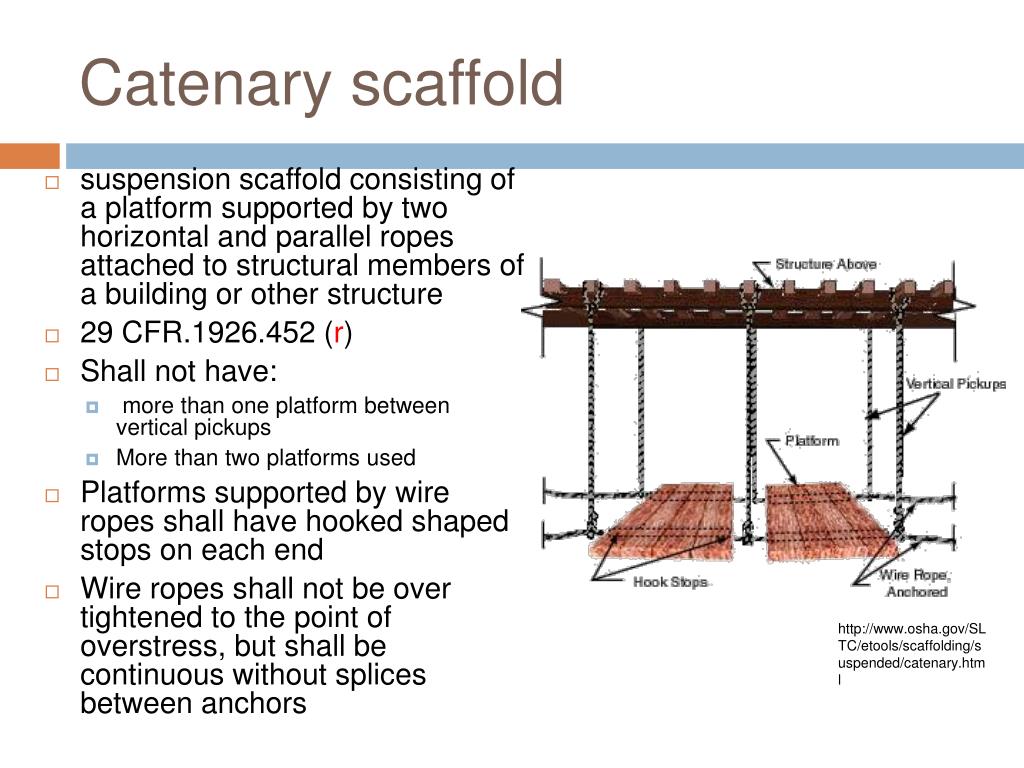
Here are some guidelines from OSHA to determine fall protection needed for some of the most common types of scaffolding:īoatswains’ Chair: Personal fall arrest systemĬatenary Scaffold: Personal fall arrest systemĬrawling Board (chicken ladder): Personal fall arrest system or a guardrail system of by a 3/4 inch (1. This means differences in the extent and type of fall protection required for the scaffolding. 33).Because each construction job is unique, different type of scaffolding is required to support work operations. Renumbering and amendment of former Section 1652 to Section 1666 filed 7-24-87 operative 8-23-87 (Register 87, No. NOTE: Authority cited: Section 142.3, Labor Code. (f) A safe means of access and egress shall be provided to the stage at all times. Shore scaffolds Lean-to scaffolds Window jack scaffolds Catenary. (See Article 24 of the Construction Safety Orders.) All scaffolds used in construction, renovation, repair (including painting and. In lieu of guardrails or safety nets, safety belts and lanyards shall be used, provided the lanyard is tied off to the structure or to a separate cable for this purpose. Suspended scaffolding is usually employed. (e) Standard guardrail shall be installed to protect all open sides and ends of staging or safety nets shall be installed. Other notable forms of suspended scaffolding include, catenary, float (or ship), single-point, and interior hung. Additional support may be provided by vertical pickups. The clamps shall be placed with the "U" on the dead end. Catenary scaffold means a suspension scaffold consisting of a platform supported by two essentially horizontal and parallel ropes attached to structural members of a building or other structure. (d) The wire rope manufacturer's recommendations with respect to the number and spacing of clamps shall be followed. A catenary scaffold is a scaffold consisting of a platform supported by two essentially horizontal and parallel ropes attached to structural members of a building or other structure. Fall Protection Methods Boatswains chair, catenary scaffold personal fall arrest Single or two point adjustable suspension scaffold personal fall. (c) A safety factor of at least 6 shall be used in determining the size of wire rope to be used.

Cables shall be continuous without splices between anchors. NOTE: It is suggested that a hanger or set of falls be used every 50 feet to pick up the sag of the wire rope. (b) Wire ropes shall not be tightened to the extent that the application of a scaffold load may overstress them. Planks shall be at least 14 inches wide and consist of "structural plank" or the equivalent. These hooks shall be so placed that they will also tend to prevent the staging members from falling if one wire rope breaks. Use fall-arrest systems when working from the following types of scaffolding: boatswains chair, catenary, float, needle beam, ladder, and pump jack 29 CFR. NOTE: It is suggested that a hanger or set.

(a) Staging supported by wire rope shall have hook-shaped stops on each end of staging members so as to prevent them from slipping off the wire ropes. (b) Wire ropes shall not be tightened to the extent that the application of a scaffold load may overstress them.


Crawling board (chicken ladder), Personal fall arrest system, or a guardrail system, or a 3/4 inch (1.9. Catenary scaffold means a suspension scaffold consisting of a platform supported by two essentially horizontal and parallel ropes attached to structural members of a building or other structure.
#CATENARY SCAFFOLD PLUS#
Staging Supported by Catenary or Horizontal Wire Ropes. rope used in catenary scaffold systems be designed to support their own weight plus six times the intended load, and that such systems shall be erected. Catenary scaffold, Personal fall arrest system.


 0 kommentar(er)
0 kommentar(er)
